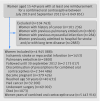Low dose oestrogen combined oral contraception and risk of pulmonary embolism, stroke, and myocardial infarction in five million French women: cohort study
- PMID: 27164970
- PMCID: PMC4862376
- DOI: 10.1136/bmj.i2002
Low dose oestrogen combined oral contraception and risk of pulmonary embolism, stroke, and myocardial infarction in five million French women: cohort study
Abstract
Objective: To assess the risk of pulmonary embolism, ischaemic stroke, and myocardial infarction associated with combined oral contraceptives according to dose of oestrogen (ethinylestradiol) and progestogen.
Design: Observational cohort study.
Setting: Data from the French national health insurance database linked with data from the French national hospital discharge database.
Participants: 4 945 088 women aged 15-49 years, living in France, with at least one reimbursement for oral contraceptives and no previous hospital admission for cancer, pulmonary embolism, ischaemic stroke, or myocardial infarction, between July 2010 and September 2012.
Main outcome measures: Relative and absolute risks of first pulmonary embolism, ischaemic stroke, and myocardial infarction.
Results: The cohort generated 5 443 916 women years of oral contraceptive use, and 3253 events were observed: 1800 pulmonary embolisms (33 per 100 000 women years), 1046 ischaemic strokes (19 per 100 000 women years), and 407 myocardial infarctions (7 per 100 000 women years). After adjustment for progestogen and risk factors, the relative risks for women using low dose oestrogen (20 µg v 30-40 µg) were 0.75 (95% confidence interval 0.67 to 0.85) for pulmonary embolism, 0.82 (0.70 to 0.96) for ischaemic stroke, and 0.56 (0.39 to 0.79) for myocardial infarction. After adjustment for oestrogen dose and risk factors, desogestrel and gestodene were associated with statistically significantly higher relative risks for pulmonary embolism (2.16, 1.93 to 2.41 and 1.63, 1.34 to 1.97, respectively) compared with levonorgestrel. Levonorgestrel combined with 20 µg oestrogen was associated with a statistically significantly lower risk than levonorgestrel with 30-40 µg oestrogen for each of the three serious adverse events.
Conclusions: For the same dose of oestrogen, desogestrel and gestodene were associated with statistically significantly higher risks of pulmonary embolism but not arterial thromboembolism compared with levonorgestrel. For the same type of progestogen, an oestrogen dose of 20 µg versus 30-40 µg was associated with lower risks of pulmonary embolism, ischaemic stroke, and myocardial infarction.
Published by the BMJ Publishing Group Limited. For permission to use (where not already granted under a licence) please go to http://group.bmj.com/group/rights-licensing/permissions.
Conflict of interest statement
Competing interests: All authors have completed the ICMJE uniform disclosure form at
Comment in
-
The vascular risks associated with combined oral contraceptives.BMJ. 2016 May 10;353:i2544. doi: 10.1136/bmj.i2544. BMJ. 2016. PMID: 27165133 No abstract available.
-
Pour réduire le risque d'événements thromboemboliques, prescrire une pilule moins dosée en oestrogène.Rev Med Suisse. 2016 Jun 15;12(523):1205. Rev Med Suisse. 2016. PMID: 27487630 French. No abstract available.
-
Low-dose second-generation oral contraceptives are associated with the lowest increased risk of cardiovascular adverse effects.Evid Based Med. 2016 Dec;21(6):232. doi: 10.1136/ebmed-2016-110500. Epub 2016 Sep 21. Evid Based Med. 2016. PMID: 27655112 No abstract available.
-
Quantifying risk of embolism with different COCP formulations.Practitioner. 2016 Nov;260(1798):11-2. Practitioner. 2016. PMID: 28968050 No abstract available.
Comment on
-
Hormonal contraception and risk of venous thromboembolism: national follow-up study.BMJ. 2009 Aug 13;339:b2890. doi: 10.1136/bmj.b2890. BMJ. 2009. PMID: 19679613 Free PMC article.
-
Risk of venous thromboembolism from use of oral contraceptives containing different progestogens and oestrogen doses: Danish cohort study, 2001-9.BMJ. 2011 Oct 25;343:d6423. doi: 10.1136/bmj.d6423. BMJ. 2011. PMID: 22027398 Free PMC article.
-
Thrombotic stroke and myocardial infarction with hormonal contraception.N Engl J Med. 2012 Jun 14;366(24):2257-66. doi: 10.1056/NEJMoa1111840. N Engl J Med. 2012. PMID: 22693997
-
Use of combined oral contraceptives and risk of venous thromboembolism: nested case-control studies using the QResearch and CPRD databases.BMJ. 2015 May 26;350:h2135. doi: 10.1136/bmj.h2135. BMJ. 2015. PMID: 26013557 Free PMC article.
References
-
- Compiled by Earth Policy Institute from U.N. Population Division. World Contraceptive Use 2011, wall chart, February 2011. www.google.fr/url?sa=t&rct=j&q=&esrc=s&source=web&cd=1&cad=rja&uact=8&ve...
-
- Vandenbroucke JP, Koster T, Briët E, Reitsma PH, Bertina RM, Rosendaal FR. Increased risk of venous thrombosis in oral-contraceptive users who are carriers of factor V Leiden mutation. Lancet 1994;344:1453-7. 10.1016/S0140-6736(94)90286-0 pmid:7968118. - DOI - PubMed
-
- Thorogood M, Mann J, Murphy M, Vessey M. Risk factors for fatal venous thromboembolism in young women: a case-control study. Int J Epidemiol 1992;21:48-52. 10.1093/ije/21.1.48 pmid:1544757. - DOI - PubMed
-
- World Health Organization Collaborative Study of Cardiovascular Disease and Steroid Hormone Contraception. Venous thromboembolic disease and combined oral contraceptives: results of international multicentre case-control study. Lancet 1995;346:1575-82. 10.1016/S0140-6736(95)91926-0 pmid:7500748. - DOI - PubMed
-
- Farmer RD, Lawrenson RA, Thompson CR, Kennedy JG, Hambleton IR. Population-based study of risk of venous thromboembolism associated with various oral contraceptives. Lancet 1997;349:83-8. 10.1016/S0140-6736(96)07496-X pmid:8996419. - DOI - PubMed
Publication types
MeSH terms
Substances
LinkOut - more resources
Full Text Sources
Other Literature Sources
Medical

